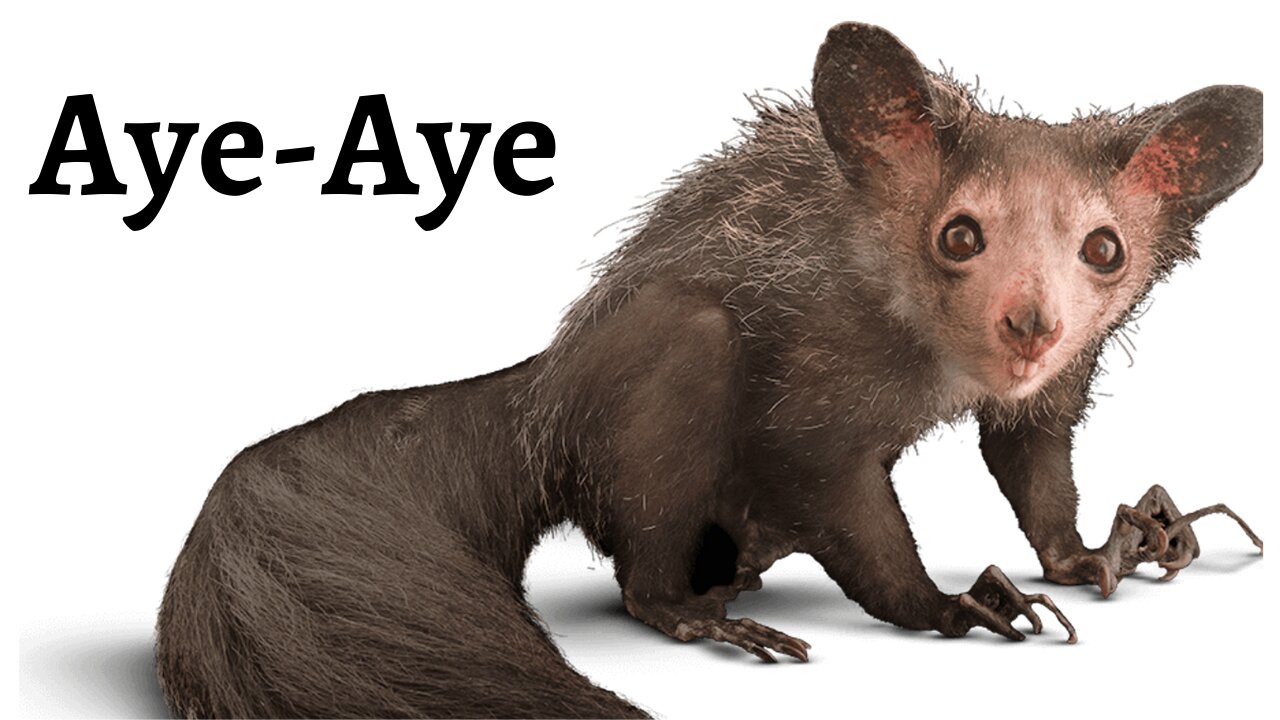Premium Only Content

Aye-Aye - Animals that carry bad luck harbingers !?
Aye-ayes can be found only on the island of Madagascar. These rare animals may not look like primates at first glance, but they are related to chimpanzees, apes, and humans. The aye-aye is the largest nocturnal lemur, best known for its distinct appearance and unusual diet. This strange lemur is a Frankenstein's monster of evolution. Ears like a bat, teeth like a rat and a witch's finger
Aye-ayes are dark brown or black and are distinguished by a bushy tail that is larger than their body. They also feature big eyes, slender fingers, and large, sensitive ears. Aye-ayes have pointed claws on all their fingers and toes except for their opposable big toes, which enable them to dangle from branches
The aye-aye is about 40 cm long, excluding the bushy 55- to 60-cm tail. Covered with long, coarse, dark brown or black fur, it has a short face, large eyes, and ever-growing incisors like those of rodents.
The aye-aye lives primarily on the east coast of Madagascar. Its natural habitat is rainforest or deciduous forest, but many live in cultivated areas due to deforestation. Rainforest aye-ayes, the most common, dwell in canopy areas and are usually sighted above 70 meters altitude. They sleep during the day in nests built from interwoven twigs and dead leaves up in the canopy among the vines and branches.
The aye-aye is a nocturnal and arboreal animal meaning that it spends most of its life high in the trees. Although they are known to come down to the ground on occasion, aye-ayes sleep, eat, travel, and mate in the trees and are most commonly found close to the canopy where there is plenty of cover from the dense foliage. During the day, aye-ayes sleep in spherical nests in the forks of tree branches that are constructed out of leaves, branches, and vines before emerging after dark to begin their hunt for food.
The aye-aye is an omnivore and commonly eats seeds, fruits, nectar, and fungi, but also insect larvae and honey. Aye-ayes tap on the trunks and branches of trees at a rate of up to eight times per second and listen to the echo produced to find hollow chambers. Once a chamber is found, they chew a hole into the wood and get grubs out of that hole with their highly adapted narrow and bony middle fingers. It's also useful for scooping the flesh out of coconuts and other fruits that supplement the animal's insect diet.
The aye-aye begins foraging between 30 minutes before and three hours after sunset. Up to 80% of the night is spent foraging in the canopy, separated by occasional rest periods. It climbs trees by making successive vertical leaps, much like a squirrel. Horizontal movement is more difficult, but the aye-aye rarely descends to jump to another tree, and can often travel up to 4 km a night.
Aye-aye is solitary animals that mark their large home range with scent. The smaller territories of females often overlap those of at least a couple of males. Male aye-ayes tend to share their territories with other males and are even known to share the same nests (although not at the same time), and can seemingly tolerate each other until they hear the call of a female that is looking for a mate.
Though foraging is usually solitary, they occasionally forage in groups. Individual movements within the group are coordinated using both vocalizations and scent signals.
Aye-ayes are commonly thought to be bad omens by some of the Malagasy people, the forests of Madagascar are being destroyed, and the farmers will kill aye-ayes to protect their crops and for poaching. However, there is no direct evidence to suggest aye-ayes pose any legitimate threat to crops and therefore are killed based on superstition. The aye-aye is often viewed as a harbinger of evil and killed on sight. Others believe, if one points its narrowest finger at someone, they are marked for death. Some say that the appearance of an aye-aye in a village predicts the death of a villager, and the only way to prevent this is to kill it. The Sakalava people go so far as to claim aye-ayes sneak into houses through the thatched roofs and murder the sleeping occupants by using their middle fingers to puncture their victims' aorta. This has led to the death of so many aye-ayes. Such hunting, coupled with habitat destruction, have put aye-aye's population at risk. Today they are protected by law. Some researchers believe aye-aye comes from the phrase “I don’t know” in Malagasy, which may be because locals were afraid to speak the name.
The aye-aye is the only extant member of the genus Daubentonia and the family Daubentoniidae. It is currently classified as Endangered by the IUCN; and a second species, Daubentonia robusta (The giant aye-aye), appears to have become extinct at some point within the last 1000 years. Successful breeding colonies have been established on a few small islands near Madagascar, and some aye-ayes are kept in captivity in a few zoos outside the country.
-
 17:50
17:50
Talk Nerdy Sports - The Ultimate Sports Betting Podcast
6 hours ago4/6/25: 🔥15-1 March Madness Run 🧠🔥 | MLB, NBA & PrizePicks Picks to Cook Your Bookie
49.4K6 -
 31:07
31:07
Real Coffee With Scott Adams
8 hours agoEpisode 2801 CWSA 04/06/25
65.3K45 -
 LIVE
LIVE
GrimmHollywood
6 hours ago🔴LIVE • GRIMM HOLLYWOOD • CLASSIC HALO • WITH THE ROCKSTARS of RUMBLE •
249 watching -
 LIVE
LIVE
MissesMaam
7 hours agoCan we survive the Oregon Trail ? 💚✨
255 watching -
 12:19
12:19
Mrgunsngear
1 day ago $7.71 earnedHUXWRX RAD 9 Suppressor Review
63K25 -
 LIVE
LIVE
JdaDelete
8 hours ago $0.09 earnedThe Legend of Zelda: Oracle of Seasons | Part 2
77 watching -
 LIVE
LIVE
LumpyPotatoX2
4 hours agoSub-Sunday with Casual Verdansk - #RumbleGaming
142 watching -
 23:50
23:50
marcushouse
19 hours ago $6.31 earnedStarship Is About to Do Something It’s Never Done Before - A Huge First!
62.1K20 -
 2:35:00
2:35:00
DJC GAME STUDIOS
3 hours ago $0.16 earnedThe Sunday BrUnCh StReAm - LIVE Retro Gaming with DJC
3.8K -
 LIVE
LIVE
FrizzleMcDizzle
5 hours agoElden Ring Seamless COOP
101 watching